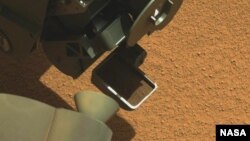The U.S. space agency NASA says its Curiosity rover discovered a bright object as it scooped up its first soil sample from the Martian surface.
In a statement released Monday, NASA says the object may be a piece that has broken off the six-wheeled robotic vehicle. NASA said the rover will not scoop any more Martian dirt until engineers determine what the object is.
Curiosity is the centerpiece of the two-year Mars Science Laboratory mission due to its ability to put soil samples into analytical instruments. NASA says mineral analysis of Martian soil can reveal past environmental conditions with chemical analysis checking for ingredients necessary for life.
The scooping was done in an area called Rocknest. The rover pulled up to the windblown, sandy and dusty location Oct. 2. Following the work at Rocknest, the rover team plans to drive Curiosity about 100 yards (about 100 meters) eastward into the Glenelg area and select a rock as the first target for use of its drill.
The nuclear powered, one-ton rover, will hunt for evidence of microbes on Mars and harvest a host of data and images from the planet. It is equipped with 17 cameras, a robotic arm, a laser and a drill.
The Curiosity rover successfully landed on Mars in August beginning a two-year, $2.5 billion mission.
Curiosity is the seventh NASA spacecraft to land on the Red Planet.
In a statement released Monday, NASA says the object may be a piece that has broken off the six-wheeled robotic vehicle. NASA said the rover will not scoop any more Martian dirt until engineers determine what the object is.
Curiosity is the centerpiece of the two-year Mars Science Laboratory mission due to its ability to put soil samples into analytical instruments. NASA says mineral analysis of Martian soil can reveal past environmental conditions with chemical analysis checking for ingredients necessary for life.
The scooping was done in an area called Rocknest. The rover pulled up to the windblown, sandy and dusty location Oct. 2. Following the work at Rocknest, the rover team plans to drive Curiosity about 100 yards (about 100 meters) eastward into the Glenelg area and select a rock as the first target for use of its drill.
The nuclear powered, one-ton rover, will hunt for evidence of microbes on Mars and harvest a host of data and images from the planet. It is equipped with 17 cameras, a robotic arm, a laser and a drill.
The Curiosity rover successfully landed on Mars in August beginning a two-year, $2.5 billion mission.
Curiosity is the seventh NASA spacecraft to land on the Red Planet.





